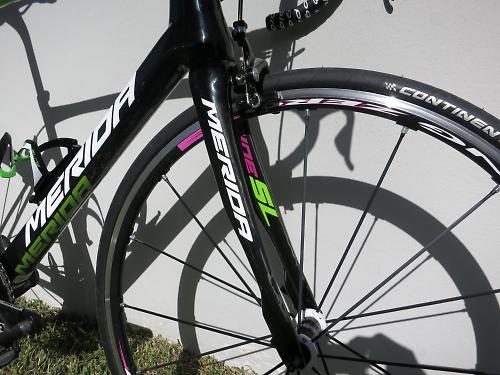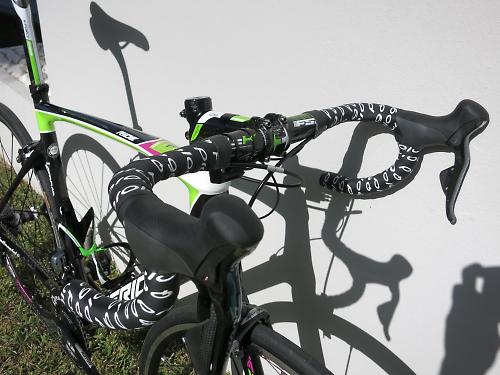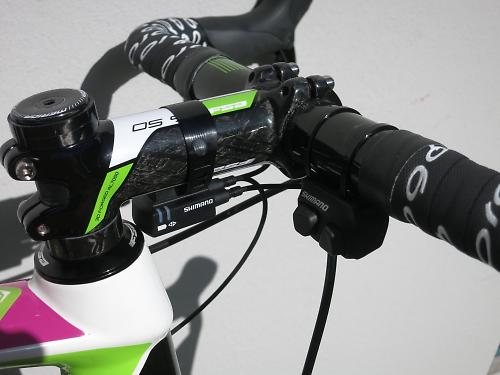- News
- Reviews
- Bikes
- Components
- Bar tape & grips
- Bottom brackets
- Brake & gear cables
- Brake & STI levers
- Brake pads & spares
- Brakes
- Cassettes & freewheels
- Chains
- Chainsets & chainrings
- Derailleurs - front
- Derailleurs - rear
- Forks
- Gear levers & shifters
- Groupsets
- Handlebars & extensions
- Headsets
- Hubs
- Inner tubes
- Pedals
- Quick releases & skewers
- Saddles
- Seatposts
- Stems
- Wheels
- Tyres
- Tubeless valves
- Accessories
- Accessories - misc
- Computer mounts
- Bags
- Bar ends
- Bike bags & cases
- Bottle cages
- Bottles
- Cameras
- Car racks
- Child seats
- Computers
- Glasses
- GPS units
- Helmets
- Lights - front
- Lights - rear
- Lights - sets
- Locks
- Mirrors
- Mudguards
- Racks
- Pumps & CO2 inflators
- Puncture kits
- Reflectives
- Smart watches
- Stands and racks
- Trailers
- Clothing
- Health, fitness and nutrition
- Tools and workshop
- Miscellaneous
- Buyers Guides
- Features
- Forum
- Recommends
- Podcast
TECH NEWS
First Ride: Merida Ride Pro Team
The Merida Ride Pro Team is the bike that the Team Lampre-Merida riders will be racing over the pavé in the Spring Classics and during this year’s Tour de France (stage 5 includes 15.4km of cobblestones, including Carrefour de l’Arbre and Arenberg), and we got to ride it on the roads of Mallorca last week.
We showed you Merida’s Reacto Evo Team aero road bike on Monday. That’s the bike that the Lampre-Merida riders will use most of the time – the default choice, if you like. The Ride Pro Team is the one they’ll pull out for the cobbles.

Merida have had a Ride series of comfort bikes for years and the Pro Team model is adapted from that range, but in more of a racing guise. In terms of geometry, the 56cm version comes with a 565mm top tube and a 195mm head tube. If you work in stack and reach, those figures are 598mm and 382mm respectively. That gives you a ride position that’s a little more relaxed than that of a standard road bike, but it’s certainly not sit-up-and-beg.
The 56cm version of Merida’s Ride Comp bikes, for comparison, have a head tubes that are 2cm taller than that of the Ride Pro Team. The stack is higher and the reach is shorter, so the ride position is more upright. The 56cm version of the Reacto Evo Team, on the other hand, has a top tube that’s 1cm longer and a head tube that’s 11mm shorter
The bottom line is that the Ride Pro Team’s geometry is somewhere between that of a standard racy road bike and that of a short and tall comfort-inspired road bike.
The basic idea of the Ride Pro Team is that it should be a race machine with added comfort for riding on poor surfaces: Paris-Roubaix, Tour of Flanders, most roads in the UK,… With that in mind, the Merida designers have gone to work on the rear triangle.

There’s a big offset in the seatstays (they meet the seat tube well below the top tube junction), for example, and the low-profile stays, called Flexstays, have been designed specifically to absorb shock. The cross section of the seatstays is just 10mm, the minimum permitted by UCI regs, and they’re flattened to encourage up-and-down movement. The chainstays slim down massively from the bottom bracket too, the idea again being to add extra comfort out back without affecting lateral rigidity. Merida use biofibre in there to absorb vibration further, a central layer of bio flax fibres within the carbon.
Merida also use a 27.2mm FSA K-Force Lite seatpost rather than one of a larger diameter to provide a little more comfort, and the Ride’s SL carbon fork has been shaped specifically to allow a degree of vertical flex. As you can see in the pictures, the fork legs taper right down before bulging out again towards the dropouts, the idea being to smooth over rough roads.

While we’re looking at the fork, you can just about make out the rear-racing mudguard mount on the back of the blade, just behind the dropout. That’s very unusual on a race bike. You get similar mounts at the rear.
The Ride Pro Team is built with what Merida call an X-Taper head tube which means that it’s externally butted with an oversized 1 1/2in lower bearing, 1 1/8in up top. It’s a chunky piece of work designed to provide steering precision.

I got a couple of hours on board the Lampre-Merida version of the Ride, a bike set up with the same equipment that the team riders use, more or less: a Shimano Dura-Ace Di2 groupset, Rotor 3D cranks with oval Q-Rings, and a Prologo Scratch Pro saddle. The seat post, stem and handlebar came from FSA while the wheels I used were Fulcrum Racing Zeros with Continental GrandPrix 4000S 23mm tyres (the team use tubular setups).

The closest version to this that you can buy in the UK is the Merida Ride CF Team. This has the mechanical version of the Dura-Ace groupset with a compact (50/34-tooth) DA chainset, and Fulcrum Racing 1 wheels. This bike also gets Conti GrandPrix 4000S 25mm tyres, the larger air chamber making even more sense than usual for a bike designed with an eye on comfort. Merida claim the weight of this model is 7.3kg (16.1lb), and it is priced at £5,500.
I found the ride to be very comfortable. It’s not just a load of hot air from the Merida marketing department, you really do get a relatively vibration-free experience here – it’s certainly a long way from harsh. The features designed to smooth things over aren’t miraculous – you’re still in contact with the road surface – but they just take the edge off things over rougher roads, and Mallorca has enough of those if you want to find them. As mentioned above, wider tyres would help further. I’d certainly be running 25s on a bike like this, but each to his/her own.

I got on pretty well with the Prologo Scratch Pro saddle too. It has quite a round profile from side to side compared to the Zero II that I used on the Reacto Evo Team. That Zero II and I didn’t really hit it off but I could have used the Scratch Pro all day without a problem although, again, that’s a case of horses for courses.

The best thing about the Ride Pro Team is that it combines that comfort with a performance edge. Personally, I don’t like a bike with a really high front end. Some people do – fine – but it’s not for me. As I said earlier, this bike has a slightly extended head tube and a slightly shortened top tube, but neither is nuts. A 195mm head tube on a bike with a 565mm effective top tube is relaxed but not crazy. Even when you’re resting your hands on the hoods, you don’t feel like you’re sitting up too high with your torso catching the wind and slowing you down. You’re still pretty efficient, and when it’s time to go to work you can get down on the drops. Even if you’re not the most flexible person in the world, chances are that won’t be too much trouble because the FSA K-Force handlebar comes with a compact bend.

The Ride Pro Team has a real turn of pace too. Sure, if lightweight is your number one concern you’ll be able to find bikes at this price that are a touch quicker off the mark, but the Pro Team doesn’t hang about, accelerating and climbing with impressive enthusiasm. Don’t forget, this is a bike that’ll be duking it out in World Tour races this year; it’s right up there in terms of all-out speed.

Who should buy this bike? If you’re after a performance-orientated road bike but you struggle with the comfort offered by standard race rigs, this is certainly one to consider.
For more info go to http://2014.merida-bikes.com.
Mat has been in cycling media since 1996, on titles including BikeRadar, Total Bike, Total Mountain Bike, What Mountain Bike and Mountain Biking UK, and he has been editor of 220 Triathlon and Cycling Plus. Mat has been road.cc technical editor for over a decade, testing bikes, fettling the latest kit, and trying out the most up-to-the-minute clothing. He has won his category in Ironman UK 70.3 and finished on the podium in both marathons he has run. Mat is a Cambridge graduate who did a post-grad in magazine journalism, and he is a winner of the Cycling Media Award for Specialist Online Writer. Now over 50, he's riding road and gravel bikes most days for fun and fitness rather than training for competitions.
Latest Comments
- hapaxlegomenon 56 min 22 sec ago
did you guys… or perhaps girls I suppose… really take points off because these tires are difficult to mount? 😭😭😭😭
- lonpfrb 2 hours 18 min ago
No, it's meant literally that the narcissistic sociopath in chief prefers all his loyal supporters in that position. I neither know, nor care, if...
- hawkinspeter 3 hours 8 min ago
Fire engine gets stuck behind east Bristol LTN bollard:...
- Rendel Harris 3 hours 53 min ago
Oh dear, you still don't understand, do you? Nobody has restricted his right to free speech, nobody has banned him from any platform, people are...
- mdavidford 4 hours 40 min ago
It's a lot harder to get hold of aftermarket mounts for lamb chops, too.
- David9694 5 hours 30 min ago
"Make me to know your ways, O LORD; teach me your paths." - Psalm 25:4
- anotherflat 5 hours 56 min ago
So uninsured?...
- Bigtwin 6 hours 52 min ago
Is the relvant authorites are so inept they can't even efficiently tax someone who sole relevant skill is that they drive a car quickly in a circle...
- Bigtwin 7 hours 40 sec ago
Clarkson. Fat moron's icon talking tocix ill-informed bollix shocker. If ever there was someone who should just be put out to grass with the rest...
- Garethhall74 7 hours 35 min ago
It will be interesting what new features or functions the new Booky and Roam V3's have, plus if any new functions get added to the element app....













Add new comment
3 comments
Looks like a dogs breakfast that thing, no thanks.
Only thing missing are some Trek concept type flames!
Thank God the British women lost the curling. I couldn't take any more. Now I'm hoping the men get thrashed by whoever.
Sure, we've won gold before, but is that any reason to force feed the country what is essentially bowls on ice?
More skating, skiing, snowboarding and jumping please!
#nomorecurling
Really like seeing mudguard mounts onbikes like this! Room for 28mm?